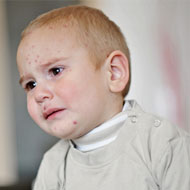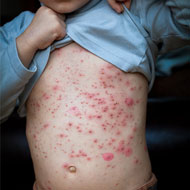- Toddler Flu Treatment
- Toddler Flu Symptoms
- Toddler Stomach Flu Symptoms
- Toddler Hair Loss
- Toddler Urinary Tract Infection Symptoms
- Toddler Tonsillectomy Recovery
- Toddler Periorbital Cellulitis
- Toddler Vomiting and Diarrhea
- Types of Toddler Vomiting
- Toddler Vomiting Treatment
- Toddler Cough Vomit
- Toddler Dandruff
- Toddler Bowlegs
- Toddler Eye Infection
- Toddler Pink Eye
- Toddler Pink Eye Symptoms
- Toddler Eye Problems
- Toddler Hearing Loss Signs
- Symptoms Of Pinworms In Toddlers
- Toddler Blood Infection
- Toddler Mononucleosis
- Toddler Motion Sickness
- Toddler Labial Adhesion
- Lyumphoma in Toddlers
- Toddler Scabies
- Toddler Pinworms
- Toddler Insect Bites
- Toddler Meningitis
- Toddler Moles
- Toddler Lyme Disease
- Toddler Nosebleeds
- Toddler Ingrown Toenail
- Toddler Lead Poisoning
- Toddler Hair Loss Alopecia Areata
- Toddler Heat Stroke
- Toddler Rubella
- Toddler Tonsillectomy
- Toddler Iron-Deficiency Anemia
- Toddler Tooth Discoloration
- Toddler Concussion
- Toddler Psoriasis
- Toddler Sunburn
- Toddler Tongue Blisters
- Toddler Impetigo
- Toddler Blepharitis
- Toddler Burns
- Toddler Burn Treatment
- Toddler Eczema Face
- Toddler Eczema Symptoms
- Toddler Urinary Tract Infection
- Toddler Boy Urinary Tract Infection
- Toddler Epilepsy
- Toddler Epilepsy Symptoms
- Toddler Walking Pneumonia
- Toddler Yeast Infection Symptoms
- Toddler Frostbite
- Toddler Hand Foot And Mouth Disease
- Toddler Dry Scalp
- Toddler Dry Skin
- Toddler Strep Throat
- Toddler Strep Throat Symptoms
- Toddler Sore Throat
- Toddler Mumps
- Toddler Bacterial Infection
- Shaken Baby Syndrome
- Shaken Baby Syndrome Symptoms
- Toddler Tonsillitis
- Toddler Eye Discharge
- Toddler Fifth Disease
- Toddler Febrile Seizures
- Toddler Food Poisoning
- Toddler Gingivostomatitis
- Toddler Stomach Ache
- Toddler Warts
- Toddler Tuberculosis
- Toddler Torticollis
- Toddler Tick Bites
- Toddler Ear Infection Remedies
- Toddler Ear Infection Symptoms
- Toddler Ear Infection Signs
- Toddler Concussion Signs
- Toddler Bronchitis
- Toddler Colds
- Toddler Chicken Pox
- Toddler Appendicitis
- Toddler Asthma
- Toddler Birthmarks
- Toddler Strabismus
- Toddler Wheezing
- Toddler Sprains
- Toddlers Tinea Versicolor
- Toddler Viral Infection
- Toddler Yeast Infection
- Toddler Hives
- Toddler Canker Sores
Signs Of Measles In Toddlers & Treating It
Measles is a viral infection affecting the respiratory system. It is commonly seen in children, although, it could affect other age groups as well. The two major types of measles are: German measles or rubella and regular measles or rubeola.
German measles lasts for about three days and is distinguishable by the red rashes that develop on the child's skin. Regular measles lasts for around seven days. Measles is highly contagious and spreads when the infected person sneezes or coughs.
Conditions of Measles in Toddlers
Conditions of Measles in Toddlers
The illness usually goes undetected until the toddler has already been infected for over eight to twelve days. All this while, the child may not exhibit any symptoms of the disease, but can potentially infect other children. After ten days of being infected, some of the common symptoms of measles in toddler that become visible are: general malaise, sneezing, coughs, nasal congestion, conjunctivitis, fever, and rashes. At this time, white spots may occur inside the child's mouth. These are typical measles spots and are known as Koplik spots. These spots usually start off by appearing inside the cheek close to the lower molars, they then spread to cover most of the child's mouth including the lower lip. Measles spots are distinguishable from other spots as they appear on a bright red, granular background inside the cheek. Measles symptoms in toddler also include a skin rash usually appears fourteen days after being exposed to the virus.
It starts off as a rash around the ears and forehead. In the next three days, it spreads across the face, neck, chest, hands, and legs. During these three days, the Koplik spots, inside the mouth, gradually disappear and the fever starts to fall.
Treatment for Measles in Toddlers
Although contagious, measles is not a medical emergency. The doctor might prescribe medication for fever but other than that measles has no specific medical treatment. Once detected, it can be treated at home by making the child feel comfortable. Ensure that the child gets sufficient rest. A sponge bath is recommended if the toddler has a fever over 100.5°F. Prevent dehydration, by giving the child enough water. Use a vaporizer or humidifier to ease the child's breathing. Oral medication should be given sparingly and only under doctor's prescription, because of the child's age and the possibility of developing Reye syndrome. The rash can be cared for by the external application of calamine lotion, which will reduce the itchy sensation. Also, trim the child's fingernails to prevent scratching as scratching the rash only causes further pain and irritation and can lead to secondary infections.


